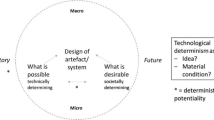Abstract
The societal demand for inspiring and engaging science, technology, engineering, and mathematics (STEM) students and preparing our workforce for the emerging creative economy has necessitated developing students’ self-efficacy and understanding of engineering design processes from as early as elementary school levels. Hands-on engineering design activities have shown the potential to promote middle school students’ self-efficacy and understanding of engineering design processes. However, traditional classrooms often lack hands-on engineering design experiences, leaving students unprepared to solve real-world design problems. In this study, we introduce the framework of a toy design workshop and investigate the influence of the workshop activities on students’ understanding of and self-efficacy beliefs in engineering design. Using a mixed method approach, we conducted quantitative analyses to show changes in students’ engineering design self-efficacy and qualitative analyses to identify students’ understanding of the engineering design processes. Findings show that among the 24 participants, there is a significant increase in students’ self-efficacy beliefs after attending the workshop. We also identified major themes such as design goals and prototyping in students’ understanding of engineering design processes. This research provides insights into the key elements of middle school students’ engineering design learning and the benefits of engaging middle school students in hands-on toy design workshops.





Similar content being viewed by others
References
Atman CJ, Adams RS, Cardella ME, Turns J, Mosborg S, & Saleem J (2007). Engineering design processes: a comparison of students and expert practitioners. J Eng Educ 96(4):359–379.
Bandura A (1986) The explanatory and predictive scope of self-efficacy theory. J Soc Clin Psychol 4(3):359–373. doi:10.1521/jscp.1986.4.3.359
Bandura, A. (2006). Guide for constructing self-efficacy scales. In: Self-efficacy beliefs of adolescents, pp 307–337. doi: 10.1017/CBO9781107415324.004
Bandura A, Barbaranelli C, Caprara GV, Pastorelli C (2001) Self-efficacy beliefs as shapers of children’s aspirations and career trajectories. Child Dev 72(1):187–206. doi:10.1111/1467-8624.00273
Carr RC, Bennett LD, Strobel J (2012) Engineering in the K-12 STEM Standards of the 50 U.S. States: An Analysis of Presence and Extent. Journal of Engineering Education 101 (3):539-564
Britner SL, Pajares F (2006) Sources of science self-efficacy beliefs of middle school students. J Res Sci Teach 43(5):485–499. doi:10.1002/tea.20131
Carberry A, Lee H-S, Ohland M (2010) Measuring engineering design self-efficacy. J Eng Educ 99(1):71–79
Clive D, Agogino A, Eris O, Frey DD, Leifer LJ, Dym CL et al (2005). Engineering design thinking, teaching, and learning. J Eng Educ 94(1):103–120. doi:10.1109/EMR.2006.1679078
Dong A, Hill AW, Agogino AM (2004) A document analysis method for characterizing design team performance. J Mech Des 126(3):378. doi:10.1115/1.1711818
English LD, Hudson PB, Dawes L (2012) Engineering design processes in seventh-grade classrooms: bridging the engineering education gap. Eur J Eng Educ 37(5):436. doi:10.1080/03043797.2012.708721
Faas D, Bao Q, Yang MC (2014) Preliminary sketching and prototyping: comparisons in exploratory design-and-build activities. Asme Idetc:1–9
Fantz TD, Siller TJ, Demiranda MA (2011) Pre-collegiate factors influencing the self-efficacy of engineering students. J Eng Educ 100(3):604–623. doi:10.1002/j.2168-9830.2011.tb00028.x
Haynes S, Richard D, Kubany E (1995) Content validity in psychological assessment: a functional approach to concepts and methods. Psychol Assess 7(3):238–247
Hirtz J, Stone R, McAdams D, Szykman S, Wood K (2002) A functional basis for engineering design: reconciling and evolving previous efforts. Res Eng Design 13(2):65–82. doi:10.1007/s00163-001-0008-3
Hu WL, Booth J, & Reid T (2015). Reducing sketch inhibition during concept generation: psychophysiological evidence of the effect of interventions. In ASME 2015 International Design Engineering Technical Conferences and Computers and Information in Engineering Conference (pp. V007T06A010-V007T06A010). American Society of Mechanical Engineers. Chicago
Hutchison MA, Follman DK, Sumpter M, Bodner GM (2006) Factors influencing the self-efficacy beliefs of first-year engineering students. J Eng Educ 95(1):39–47. doi:10.1002/j.2168-9830.2006.tb00876.x
Booth JW, Taborda EA, Ramani K, & Reid T (2016) Interventions for teaching sketching skills and reducing inhibition for novice engineering designers. Design Studies 43:1-23
Kolodner JL, Camp PJ, Crismond D, Fasse B, Gray J, Holbrook J et al (2003) Problem-based learning meets case-based reasoning in the middle-school science classroom: putting learning by design(tm) into practice. Journal of the Learning Sciences 12(4):495–547. doi:10.1207/S15327809JLS1204_2
Lent RW, Lopez F, Brown S, Gore P (1996) Latent structure of the sources of mathematics self-efficacy. J Vocat Behav 49(3):292–308. doi:10.1006/jvbe.1996.0045
Lent RW, Sheu HB, Singley D, Schmidt J a, Schmidt LC, Gloster CS (2008) Longitudinal relations of self-efficacy to outcome expectations, interests, and major choice goals in engineering students. J Vocat Behav 73(2):328–335. doi:10.1016/j.jvb.2008.07.005
Marra RM, Rodgers KA, Shen D, Bogue B (2009) Women engineering students and self-efficacy: a multi-year, multi-institution study of women engineering student self-efficacy. J Eng Educ 98(1):27–38. doi:10.1002/j.2168-9830.2009.tb01003.x
Mccoach DB, Gable R K, & Madura JP (2013). Instrument development in the affective domain. Springer, New York
Mentzer N, Becker K, Sutton M (2015) Engineering design thinking: high school students’ performance and knowledge. J Eng Educ 104(4):417–432. doi:10.1002/jee.20105
Moreno NP, Tharp BZ, Vogt G, Newell AD, Burnett CA (2016) Preparing students for middle school through after-school STEM activities. J Sci Educ Technol 25(6):889–897. doi:10.1007/s10956-016-9643-3
Pajares MF (1992) Teachers’ beliefs and educational research: cleaning up a messy construct. Rev Educ Res 62(3):307–332. doi:10.3102/00346543062003307
Peppler K (2013) STEAM-powered computing education: using E-textiles to integrate the arts and STEM. Computer 46(9):38–43. doi:10.1109/MC.2013.257
Peppler K, Bender S (2013) Maker movement spreads innovation one project at a time. Phi Delta Kappan 95(3):22–27. doi:10.1177/003172171309500306
Plant EA, Baylor AL, Doerr CE, Rosenberg-Kima RB (2009) Changing middle-school students’ attitudes and performance regarding engineering with computer-based social models. Computers and Education 53(2):209–215. doi:10.1016/j.compedu.2009.01.013
Reid FJM, Reed SE (2005) Speaker-centredness and participatory listening in pre-expert engineering design teams. CoDesign 1(1):39–60. doi:10.1080/15710880412331289944
Schunk DH, & Meece JL (2006). Self-efficacy development in adolescence. Self-efficacy beliefs of adolescents, pp 71–96
Usher EL, Pajares F (2008) Sources of self-efficacy in school: critical review of the literature and future directions. Rev Educ Res 78(4):751–796. doi:10.3102/0034654308321456
Author information
Authors and Affiliations
Corresponding author
Rights and permissions
About this article
Cite this article
Zhou, N., Pereira, N.L., George, T.T. et al. The Influence of Toy Design Activities on Middle School Students’ Understanding of the Engineering Design Processes. J Sci Educ Technol 26, 481–493 (2017). https://doi.org/10.1007/s10956-017-9693-1
Published:
Issue Date:
DOI: https://doi.org/10.1007/s10956-017-9693-1




